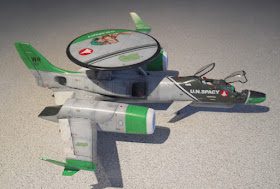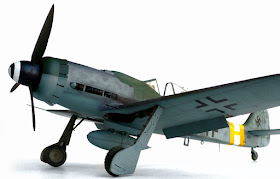This is a model of Hans Rudel's aircraft with a winter scheme.
I tried to make the splotches as quick and haphazard looking as I could. As it was done in the field with white wash and paint brushes.
From Wikipedia"
Hans-Ulrich Rudel, a Stuka ace, had suggested using two 37 mm (1.46 in) Flak 18 guns, each one in a self-contained under-wing gun pod, as the Bordkanone BK 3,7, after achieving success against Soviet tanks with the 20 mm MG 151/20 cannon. These gun pods were fitted to a Ju 87 D-1, W.Nr 2552 as "Gustav the tank killer" - the co-incidence of "Gustav" being the standard word for "G" in the Germans' own spelling alphabet of the time could have inspired the choice of letter for the subtype. The first flight of the machine took place on 31 January 1943, piloted by Hauptmann Hans-Karl Stepp. The continuing problems with about two dozens of the Ju 88P-1, and slow development of the Henschel Hs 129B-3, each of them equipped with a large, PaK 40-based, autoloading Bordkanone 7,5 7.5 cm (2.95 in) cannon in a conformal gun pod beneath the fuselage, meant the Ju 87G was put into production. In April 1943, the first production Ju 87 G-1s were delivered to front line units.The two 37 mm (1.46 in) cannons were mounted in under-wing gun pods, each loaded with two six-round magazines of armour-piercing tungsten carbide-cored ammunition. With these weapons, the Kanonenvogel ("cannon-bird"), as it was nicknamed, proved spectacularly successful in the hands of Stuka aces such as Rudel. The G-1 was converted from older D-series airframes, retaining the smaller wing, but without the dive brakes. The G-2 was similar to the G-1 except for use of the extended wing of the D-5. 208 G-2s were built and at least a further 22 more were converted from D-3 airframes.
Only a handful of production Gs were committed in the Battle of Kursk. On the opening day of the offensive, Hans-Ulrich Rudel flew the only "official" Ju 87 G, although a significant number of Ju 87D variants were fitted with the 37 mm (1.46 in) cannon, and operated as unofficial Ju 87 Gs before the battle. In June 1943, the RLM ordered 20 Ju 87Gs as production variants. The G-1 later influenced the design of the Fairchild Republic A-10 Thunderbolt II, with Hans Rudel's book, Stuka Pilot being required reading for all members of the A-X project.





























